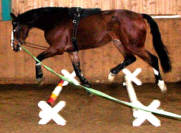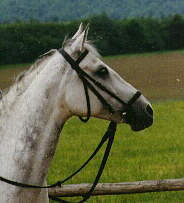
powered by FreeFind
| Main Page | Address |
| A-Z | Forum |
| German Main Page | |
|
Search
Web Search powered by FreeFind |
|
||||||||
 |
reiter.spass.com
Joy and Fun with Horses and Horseback Riding |
 |
Solving problems concerning supplenessWhat to do if the horse doesn’t relax and if its muscles don’t getting flexible? Authored by Beate Schulze and translated by Martina Wald |
||
|
|||||||||||||||
|
Contents
The reasonsIf your horse does not show any signs of suppleness or it continues to tense the neck and back after the relaxation phase, this can be caused by various matters: Tension in the spine and in the neck muscles Have you ever tried to be relaxed while ducking the poll? Please try it. Ducking your poll that the head is more or less sitting directly on your shoulders, your shoulders will get tensed and spine together with your neck will get completely immobile. Turns in spine are only possible for minimal movements.
The neck muscles get very hard and an indicative or massive lower neck is caused. The big muscle part develops along the lower part of the neck. In such positions the spine blocks as well. The horse cannot move with a swinging back and a dropping neck, the hindlegs stand outside and move often with unequal steps. That feels absolutely the same as if you duck your poll, so it is completely tensed. To solve this problem, you have to
change between flexion to the in- and outside again and again. We can
practise this in walk, trot and canter. Due to the flexion the muscles
will be stretched on one side of the neck. On the other side of the neck
they contract.
To make this better understandable, we make a little excursion into flexion and bend Flexion is only possible in the area
of the first neck whirl the so called Atlas. Bend Bend works in the complete body, it starts in the neck and ends at the tail. The bend of the neck’s spine must not be stronger than the bend of the back's spine. Examples:
As one side of the neck muscles is
in a relaxed condition the horse can now drop the neck and receives a
stretching in the longitudinal direction, which relaxes the muscles again.
First exercise: Riding B-X-E (E-X-B) without change
of rein, you have to give bend before riding the corners (circle
point, 6 metres in front of the corner) by giving flexion and moving forward
with the inside leg, riding into the corner (the leg is lying at the
girth) as if you wanted to ride leg yielding – you limit the horse with your
outside and out of the hip back positioned leg, thus leg
yielding is not possible – but you get the correct bend and flexion. If than the horse drops its neck, you allow the reins as far as the mouth has reached the position between the elbow and the joints of the upper part of the forehand. Therefore the horse does not roll up its neck but has to stretch it forward-downward and into length.
When starting the relaxation part you can work with 3 – 5 cavalettis (with a distance of 80 cm at the circle point). Now let your horse move about the poles (most horses are stretching their necks while moving over the poles). Than you turn into the circle straight away keeping the flexion and bend and than let your horse move over the poles once more. Third exercise: Once again put 3 – 5 cavalettis at the circle point with a distance of 80 cm. After the cavaletti work turn into the circle once more and at the open side of the circle you let your horse training leg yielding of the inside leg. |
| Copyright © 2003 / 2007 reiter.spass.com, Forchheim, Germany | Disclaimer of reiter.spass.com | |
|
|
||